Wife of President Thomas Jefferson
Martha Wayles was born at The Forest in Charles City County – near Williamsburg, Virginia – on October 30, 1748. Her parents were John Wayles and his first wife Martha (Patsy) Eppes, wealthy plantation owners. Martha’s mother was the daughter of Francis Eppes of Bermuda Hundred, a huge Virginia plantation. Patsy died when her daughter Martha was only three weeks old.
No record of her early years exist but in light of her father’s wealth and prominence, Martha Wayles was likely educated at home by traveling tutors in literature, poetry, French, and Bible study; she likely received considerable training in music. Certainly a young woman of her region, era, and wealth would also be trained in sewing and medicinal preparations.
Martha probably played a social role at the Wayles plantation; her later skills at Monticello would also suggest she received basic training on running a plantation, making household staples; she also assisted her father with management of crop business accounting.
Martha Wayles married Bathurst Skelton in 1766; they lived at his Charles City County plantation and had one son, John Wayles Skelton. Bathurst Skelton died in September 1768 at Williamsburg after an accident, leaving Martha a rich widow, and she moved back into her father’s house.
Thomas Jefferson was born on April 13, 1743, in Albemarle County, Virginia, the third child of Peter Jefferson, a surveyor, and Jane Randolph, daughter of a distinguished Virginia family. Their estate, Shadwell, was on the banks of the Rivanna River in the sparsely populated Piedmont Region, between the gentrified Tidewater coastline and the Blue Ridge Mountains of the frontier. Throughout his life, Jefferson would occupy a political and psychological space that balanced the responsibilities of establishment privilege with the lures of open, unexplored territory.
In 1760, Jefferson entered the College of William and Mary in Williamsburg at the age of 16; he studied there for two years. At William and Mary, he enrolled in the philosophy school and studied mathematics, metaphysics, and philosophy. A keen and diligent student, according to the family tradition, and he frequently studied fifteen hours a day. In addition to his academic pursuits, young Thomas excelled as a horseman and violinist.
After graduating with highest honors in 1762, he read law with George Wythe, Virginia’s most eminent legal scholar of that era, and was admitted to the Virginia bar in 1767. Jefferson handled many cases as a lawyer in colonial Virginia, more than a hundred each year between 1768 and 1773 in General Court alone, while acting as counsel in hundreds of cases. His client list included members of Virginia’s most elite families, including members of his mother’s family, the Randolphs.
The Jefferson Marriage
Sometime in 1770, probably in Williamsburg, Martha Wayles Skelton – the widow of Jefferson’s classmate at William and Mary, Bathurst Skelton – met a rather shy attorney and scholar named Thomas Jefferson, who was then serving in the House of Burgesses. When Jefferson began courting her in December 1770, she was living again at The Forest with her young son, John, who died suddenly of a fever on June 10, 1771, when she was already engaged to Jefferson.
Family tradition says that Martha was accomplished and beautiful – slender figure, hazel eyes, and auburn hair – and wooed by many. Jefferson found Martha especially attractive because of her education and her penchant for music. Throughout their courtship in 1770 and 1771, the young couple frequently harmonized together, she singing while he played accompaniment on piano.
Martha married Thomas Jefferson on New Year’s Day, 1772, at the bride’s plantation home, The Forest, near Williamsburg. The Jeffersons honeymooned there for two weeks before setting out in a two-horse carriage for a cottage on the property that would become Monticello, though the mansion house was not yet built. They made the 100-mile trip in one of the worst snowstorms ever to hit Virginia. Some miles from their destination, their carriage bogged down in two feet of snow, and they had to complete the journey on horseback.
Arriving at Monticello late at night after the slaves had banked the fires and retired for the night, the couple settled in the freezing one-room brick building that was to be their home until completion of the famous main house. They toasted their new home with a leftover half-bottle of wine and “song and merriment and laughter.” That night, on their own mountaintop, the love of Thomas Jefferson and his bride seemed strong enough to endure any adversity.
The birth of their daughter Martha the following September increased their happiness. Within ten years, Martha gave birth to five more children. Of them all, only two survived to adulthood: Martha, called Patsy, and Mary, called Polly. Because of her frailty, of the six children Martha bore in less than ten years, all were weak as infants.
Martha was in frail health for much of her marriage. With each succeeding pregnancy, Martha grew weaker and weaker. But even as pleasures turned to pains, Jefferson remained by Martha’s side, declining numerous appointments at both the state and national levels in order to be with his ailing wife. She is now believed to have suffered from diabetes, the cause of her problems in childbirth.
In 1773, the death of Martha’s father brought the Jeffersons a great increase of fortune – 40,000 acres of land and 135 slaves – which doubled Jefferson’s estate. In the eighteen months between his marriage and the death of his father-in-law, Jefferson had watched as the Wayles fortune turned sour amidst a series of bad business deals. Now, Jefferson was left with the majority of Wayles’ holdings, but also the majority of his debt.
Added to his prior holdings, this put him in the upper echelon of landed and slave-owning gentry in Virginia. Such a distinction must have come as a mixed blessing to Jefferson, who had already gone on record with his philosophical objections to slavery. He would continue to condemn the peculiar institution in the abstract throughout his life, all the while continuing to function as a large-scale slaveowner.
In order to pay off Wayles’ debts, Jefferson sold off a portion of the inherited lands and slaves, and funneled what few resources he could gather into improvements at Monticello. Throughout his life, Jefferson would value the improvement of lands and the possession of slaves over the retention of capital. The constant additions and renovations to Monticello, coupled with Jefferson’s extravagant tastes and bent for playing host, would keep him in a constant spiral of debt that did not seem to bother him all that much.
As a newlywed, Jefferson delved for the first time into the full-fledged life of a country gentleman, giving special care and attention to the cultivation of his garden and his experiments with crops. His very personality seemed to congeal: as one biographer notes, Jefferson’s handwriting, which had previously been erratic and variable, steadied into a recognizable style only after his marriage.
Jefferson was devoted to Martha, so much so that he tended at times to neglect his professional career in favor of domestic pleasures. Ultimately, Jefferson’s attentions may have boded poorly for Martha, who grew weak from the strain of repeated pregnancies. Yet, despite her frequent poor heath, she was by all accounts devoted to Jefferson as well.

West Front of Monticello
Jane Pitford Braddick Peticolas, Artist
Much as she had for her father during his periods of widowhood, Martha ran the plantation life of Monticello. It was a considerable responsibility: reading recipes to slaves and overseeing food preparation in the kitchens; food preservation; clothing needs for the family and slaves; and managing the house slaves and their responsibilities. Among the few remaining examples of her handwriting is a precise ledger of the plantation’s main cash crop, tobacco, suggesting she worked with Jefferson more as a full partner in this aspect of life at Monticello.
For the first three years of her marriage, while Jefferson was still a member of the House of Burgesses, Martha Jefferson would likely have accompanied him to the colonial capital of Williamsburg when the burgesses was in session, and taken part in the social life there, which she had done in her early years.
Thomas and Martha Jefferson were both talented in music. A Hessian officer who visited Jefferson at Monticello in 1780 noted, “You will find in his house an elegant harpsichord piano forte and some violins. The latter he performs well upon himself, the former his lady touches very skillfully and who, is in all respects a very agreeable, sensible. and accomplished lady.”
Jefferson’s political career began in May 1769, when he became a member of the Virginia House of Burgesses. While not considered an effective public speaker, Jefferson gained a reputation as a gifted writer. Unable to attend the Virginia Convention of 1774, Jefferson sent instructions for the Virginia delegates to the first Continental Congress. These proposals, eventually published as A Summary View of the Rights of British America, asserted that the American colonies’ only legitimate political connection to Great Britain was through the king, to whom they had submitted voluntarily, and not to Parliament.
Freckled and sandy-haired, rather tall and awkward, Jefferson contributed his pen rather than his voice to the patriot cause. His reputation began to reach beyond Virginia in 1774, when he wrote a political pamphlet, A Summary View of the Rights of British America. Arguing on the basis of natural rights theory, Jefferson claimed that colonial allegiance to the king was voluntary. “The God who gave us life,” he wrote, “gave us liberty at the same time: the hand of force may destroy, but cannot disjoin them.”
Drafting the Declaration of Independence
Jefferson was elected as a delegate to the Second Continental Congress in Philadelphia in June 1775, soon after the beginning of the Revolutionary War. The following year, on June 11, 1776, Jefferson was appointed to head the Committee of Five in preparing a declaration of independence from Great Britain.
The committee selected Jefferson to write the first draft, probably because of his reputation as a writer. The assignment was considered routine; no one at the time thought that it was a major responsibility. At the age of 33, he became the document’s principal author, and later counted it among his three proudest lifetime achievements.
Based upon the same natural rights theory contained in his paper, A Summary View, and his proposed draft of the Virginia Constitution, Jefferson wrote a stunning statement of the colonists’ right to rebel against the British government, which officially separated the Colonies from Great Britain.
Amending his initial version after consultation with Benjamin Franklin and John Adams, Jefferson presented his draft to the committee, which made some final revisions, and then presented it to Congress on June 28, 1776. Over several days of debate, Congress made a few changes in the wording, and deleted nearly a fourth of the text, most notably a long passage that attributed responsibility of the slave trade to King George III, a change that Jefferson resented.
On July 4, 1776, the wording of the Declaration of Independence was approved. Drafting the Declaration of Independence in 1776 became the defining event in Thomas Jefferson’s life, and made him internationally famous. His eloquent preamble became an enduring statement of human rights.
The “original Rough draught” of the Declaration of Independence is one of the great milestones in American history. After hearing the Declaration of Independence read on July 9, the American army destroyed the statue of King George III at the foot of Broadway in New York City.
Thomas Jefferson’s Signature
On the Declaration of Independence
In that famous summer of 1776, Martha suffered a miscarriage and was very ill, and Jefferson was desperate to get out of Philadelphia as soon as possible to be by her side. In September 1776, Jefferson returned to Virginia and was soon elected to the new Virginia House of Delegates, where he served until 1779.
During his term in the Virginia House, Jefferson set out to reform and update Virginia’s system of laws to reflect its new status as a democratic state. He drafted 126 bills in three years, including laws to abolish primogeniture (the right of the firstborn son to inherit the entire estate), to establish freedom of religion, and to streamline the judicial system.
Joined by his old law teacher, George Wythe, and by James Madison and George Mason, Jefferson introduced a number of bills that were resisted fiercely by those representing the conservative planter class. Jefferson was also instrumental in devising a major revision of the criminal code, although it was not enacted until 1796. His bill to create a free system of tax-supported elementary education for all except slaves was defeated, as were his bills to create a public library and to modernize the curriculum of the College of William and Mary.
In June 1779, the introduction of Jefferson’s bill on religious liberty touched off a quarrel that caused turmoil in Virginia for eight years. The bill was significant as no other state – indeed, no other nation – provided for complete religious liberty at that time. Jefferson’s bill stated “that all men shall be free to profess, and by argument to maintain, their opinions on matters of religion, and that the same shall in no wise diminish, enlarge, or affect their civil capacities.”
Many Virginians regarded the bill as an attack upon Christianity. It did not pass until 1786, and then mainly through the perseverance of James Madison. Jefferson, by then in France, congratulated Madison, adding that “it is honorable for us to have produced the first legislature who had the courage to declare that the reason of man may be trusted with the formation of his own opinions.”
Governor of Virginia
In June 1779, Jefferson was elected governor of Virginia, a position he held until 1781. As governor, he oversaw the transfer of the state capital from Williamsburg, which was then more vulnerable to British attack by sea, to the more central location of Richmond in 1780. Martha briefly joined him there.
The British invaded Virginia twice during Jefferson’s term as governor. On January 3, 1781, a British invasion led by Benedict Arnold forced Martha Jefferson to flee Monticello for their more isolated Bedford County home, Poplar Forest, and it weakened her 16-month old daughter Lucy, who died three months later.
In June 1781, Jefferson narrowly escaped capture, fleeing on horseback as Lt. Colonel Banastre Tarleton’s forces ascended Carter’s Mountain toward Monticello, two days after Jefferson’s gubernatorial term expired. Jefferson had already decided not to seek reelection to a third term, but his perceived abdication at this critical juncture earned him considerable scorn.
His political enemies criticized his performance as war governor mercilessly. He was charged with failure to provide for the adequate defense of Richmond, although he knew a British invasion was imminent, and of cowardice and “pusillanimous conduct” when he fled the capital during the moment of crisis. Deeply mortified by the public scrutiny and increasingly alarmed by his wife’s serious illness, Jefferson retired from the governorship.
The Virginia house of delegates immediately ordered an investigation into his conduct, only to join with the state Senate in exonerating the former governor after he appeared before both houses six months later to explain his actions. In fact, the assembly unanimously voted a resolution of appreciation of his conduct. The episode left Jefferson bitter, however, about the rewards of public service. Public disapproval of his performance delayed his future political prospects, and he was never again elected to office in Virginia.
Martha’s Death
During the opening years of the Revolutionary War, while serving in the Virginia Assembly, Jefferson had preferred to compose legal briefs and policy proposals from the comfort of home. He skipped many legislative meetings to be at Martha’s side, and was frequently fined for his absence. This cavalier approach had become much more difficult while he was governor, and he had returned to Monticello permanently in June 1781, and promised his wife that he would refuse any more political posts.
Martha’s final pregnancy proved more burdensome than her marital separations. She bore another daughter, Lucy Elizabeth, on May 8, 1782, and never regained a fair measure of strength. Jefferson wrote on May 20 that her condition was dangerous. After the birth, Martha’s health began to rapidly deteriorate. She fought it off for several weeks.
On her deathbed, Jefferson promised Martha that he would never remarry. This request sprung from a desire to shield her children from the influence of an unsympathetic stepmother such as the two she herself had endured in childhood. Jefferson was despondent from the moment Martha slipped into her final coma, at which time he fainted and had to be carried out of the room.
Martha Wayles Skelton Jefferson died at Monticello on September 6, 1782, at the age of 33, leaving three daughters, the youngest four months old. After months of tending her devotedly, Jefferson noted in his account book for September 6, “My dear wife died this day at 11:45 A.M.”
The exact cause of Martha’s death is not known, however a letter from Jefferson to the Marquis de Chastellux would indicate that she never recovered from this last birth. In this letter, Jefferson refers to “…the state of dreadful suspense in which I had been kept all the summer and the catastrophe which closed it.” He goes on to say, “A single event wiped away all my plans and left me a blank, which I had not the spirits to fill up.” Jefferson buried his wife in the graveyard at Monticello.
Jefferson was distraught and for years suffered from deep depression. He spent three weeks in mourning in his library, followed by a period of seclusion, in which his only activity was a series of long horseback rides with his daughter Patsy. For months, he struggled to recapture a sense of normalcy in his life, and it is believed that with Martha’s death something integral in him died also.
In June 1783, he became a delegate to the Congress under the Articles of Confederation and served on several major committees. During his service, he prepared various influential committee papers, including a report of March 22, 1784, calling for prohibition of slavery in the western territory after the year 1800. In November, Jefferson agreed to serve as commissioner to France, taking his daughter Patsy with him in 1784 and sending for Polly later.
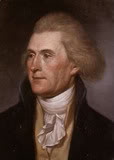
Thomas Jefferson in 1791
Charles Willson Peale, Artist
The Jefferson Slaves
As part of her dowry when Patsy Eppes (Martha Jefferson’s mother) married John Wayles, Patsy brought with her an African slave woman and her eleven-year-old half-black, half-white daughter, Elizabeth Hemings. The woman, enslaved in Africa, sailed to Virginia on a slave ship commanded by an English sea captain named Hemings. The slave and her daughter were sold to Francis and Frances Eppes, who gave the young slave girl to their daughter Patsy Eppes.
The Wayles/Eppes marriage contract stipulated that the slave mother and child were to remain the property of Patsy Eppes and her heirs forever, or be returned to the Eppes family should there be no heirs. This is how the Hemings slaves eventually came into the custody of Thomas Jefferson.
Like many widowed aristocrats in Virginia, Martha Jefferson’s father, John Wayles, had turned to one of his female slaves for comfort and companionship toward the end of his life. And, like her mother before her, Elizabeth Hemings gradually became the long-term mistress to her master, and had several children by him, the youngest of whom was the famed Sally Hemings.
Thus, when Thomas Jefferson inherited Wayles’ holdings, he gained a family of slaves who were the unacknowledged Martha’s half-siblings – Robert, James Thenia, Critta, and Sally Hemings. Since they were one-quarter African and three-quarters white, the five Wayles-Hemings children occupied a unique role within the Jefferson family. They worked in the most personal and private roles at Monticello.
In 1790, Robert Hemings bought his freedom and joined his wife and daughter in Richmond, where they worked for a doctor. James Hemings was particularly close to Jefferson, working as his personal aide or body servant, traveling with him to Philadelphia during the Second Continental Congress and later to Europe. While in Paris, James Hemings studied the culinary French arts; upon returning to Virginia, he trained his younger brother to oversee the detailed French cooking that Jefferson now insisted on serving.
Jefferson gave James Hemings his freedom. Critta Hemings helped to raise her half-nieces, Patsy and Polly. Thenia Hemings was the only one of Martha Jefferson’s half-siblings who was sold as a slave – to family friend and future president, James Monroe.
As a DNA study believed accurate by officials at Monticello indicate, Jefferson and his half sister-in-law Sally Hemings parented at least one, possibly several illegitimate children, after the death of Martha Jefferson. Public knowledge of even the rumors that the President parented several slave children became a scandal during his Administration.
Sally Hemings’ children were born after she returned with Jefferson from France. The timeline of Jefferson’s activities by historian Dumas Malone demonstrates that Jefferson was in residence at Monticello when each of the children was conceived, although for years he was away for extended periods of time when in political office. The Hemings children were afforded some special opportunities. Jefferson’s grandson Thomas Jefferson Randolph said that all the children resembled Jefferson and that one of the boys “looked almost exactly like him.”
Four of his children with Hemings survived: Beverley, Harriet, Madison, and Eston. In his will, Thomas Jefferson made provision that Madison and Eston Hemings be given their freedom when they reached 21 years of age. Sally Hemings was not freed but was allowed to live free with her sons Madison and Eston. So the entire Hemings nuclear family left Monticello as free persons. Because Virginia law required a freed slave to leave the state within one year, Jefferson asked the Virginia Assembly to grant the freed slaves permission to remain in the state “where their families and connections are.” The request was granted.
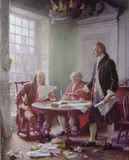
Drafting the Declaration of Independence
Jean Leon Gerome Ferris, Artist
Benjamin Franklin, John Adams and Thomas Jefferson (standing)
Thomas Jefferson succeeded Benjamin Franklin as United States Minister to France in 1785. Though he was still in Europe when the Federal Constitution was written in 1787, he was able to influence the development of the federal government through his correspondence. In the various public offices he later held, Jefferson sought to establish a federal government of limited powers. Jefferson also played a major role in the planning, design, and construction of a national capitol and the federal District of Columbia.
When Jefferson returned from France in December 1789, he accepted President George Washington’s appointment as the nation’s first Secretary of State. Progressively harsher disputes with Treasury Secretary Alexander Hamilton troubled his tenure in that office. Their differences grew out of fundamentally conflicting interpretations of the Constitution and the scope of federal power. His sympathy for the French Revolution led him into further conflict with Hamilton.
Worn out from his battles with Hamilton, Jefferson resigned as Secretary of State at the end of 1793, and handed leadership of the emerging Republican party to his fellow Virginian James Madison. Sharp political conflict developed, and two separate political parties, the Federalists and the Democratic-Republicans, began to form. Jefferson gradually assumed leadership of the Republicans, who sympathized with the revolutionary cause in France. Attacking Federalist policies, he opposed a strong centralized Government and championed the rights of states.
The Jefferson Presidency
As a reluctant candidate for President in 1796, Jefferson came within three votes of election. Through a flaw in the Constitution, he became Vice President, although an opponent of President John Adams. In 1800, the defect caused a more serious problem. Republican electors, attempting to name both a President and a Vice President from their own party, cast a tie vote between Jefferson and Aaron Burr. The House of Representatives settled the tie.
On February 17, 1801, after thirty-six ballots, the House of Representatives elected Thomas Jefferson president of the United States. Jefferson and the defeated incumbent, John Adams, established the principle that power would be passed peacefully from losers to victors in presidential elections.
On March 4, 1801, Jefferson took the oath of office as president of the United States, thereby successfully accomplishing the nation’s first transfer of presidential power between the two major political parties. While president, Jefferson’s principles were tested in many ways.
He slashed Army and Navy expenditures, cut the budget, eliminated the tax on whiskey so unpopular in the West, yet reduced the national debt by a third. In order to purchase the Louisiana Territory from France in 1803, he was willing to expand his narrow interpretation of the Constitution. But he stood firm in ending the importation of slaves and maintaining his view of the separation of church and state.
Martha Jefferson’s name appears on the White House’s official list of First Ladies, although she had been dead almost twenty years before her husband became President. She is the first of five women who were married to men who would become President after their deaths.
Martha Jefferson Randolph, eldest daughter of Thomas and Martha Jefferson, has often been incorrectly identified as the White House hostess during the eight-year Jefferson presidency. In fact, she spent almost his entire time in the White House at either Monticello or her husband’s Virginia plantation, Edgehill. She bore four of her twelve children during the eight-year Administration, giving birth on January 17, 1806, to her eighth child, James Madison Randolph, who became the first child born in the White House.
However, largely through their correspondence, but also during his lengthy visits home, Patsy Randolph became her father’s comfort and close advisor, perhaps the single most important personal factor that stabilized him during his presidency. When the newspaper story that Jefferson and his slave Sally Hemings had children out of wedlock was first widely reprinted in the first weeks of 1802, Patsy Randolph immediately joined her troubled father in Washington, along with her two children and her sister Polly Eppes, as a sign of family unity.
During the Jefferson administration, the hostess functions of a First Lady were performed by Dolley Madison, the socialite wife of his friend and highest-ranking Cabinet member, Secretary of State James Madison. At large open gatherings in the White House, Dolley Madison also assumed a public role as hostess, assisting the President in welcoming the general citizenry.
Dolley Madison thus stepped into the role of Thomas Jefferson’s presidential hostess. She followed the example set by Abigail Adams and infused the role with an even deeper political consciousness. She attended Senate debates and sparred with the British minister’s wife, defending Jefferson’s relaxed notions of etiquette. She frequently asked husband James Madison for the latest news on the country’s international relations, suspended White House entertainments during the Barbary Wars, and supported the Lewis and Clark expedition by heading a campaign to gather necessary supplies.
Although politically attuned, Dolley was equally attentive to her role as social hostess. She handled receptions and, with Jefferson’s assent, even guided friends through the presidential mansion. Though the role of presidential hostess had taken on added prestige, the person who held the position was not immune to public censure or personal attack.
Critics openly debated the nature of Dolley Madison’s relationship with Jefferson, especially as James Madison prepared to run for the presidency in 1808. Dolley’s friendship with Thomas Jefferson fueled rumors that she was his mistress. Jefferson seemed rather amused by it all, thinking that his “age and ordinary demeanor” would have negated such innuendo. Yet further insinuations levied by Congressmen, suggesting that Dolley traded sexual favors for electoral votes, sparked a full-fledged sex scandal. Despite such tactics, James Madison won both his party’s nomination and the subsequent presidential election, and Dolley Madison became First Lady in her own right.
In 1803, while Thomas Jefferson was President, the Lewis and Clark expedition set off to explore the Louisiana Territory that Jefferson had recently purchased from France, particularly the Pacific northwest. All of Washington society was intrigued by this expedition, and Jefferson waited anxiously for news about this vast area of land that he had added to the United States.
During Jefferson’s second term, he was increasingly preoccupied with keeping the Nation from involvement in the Napoleonic wars, though both England and France interfered with the neutral rights of American merchantmen. Jefferson’s attempted solution, an embargo on American shipping, worked poorly and was unpopular. In the end, Jefferson completed two full and eventful terms as president. He also paved the way for James Madison and James Monroe, his political protégés, who succeeded him in the presidency.
Retirement
After leaving the Presidency in 1809, Jefferson continued to be active in public affairs. He also became increasingly concerned with founding a new institution of higher learning, specifically one free of church influences, where students could specialize in many new areas not offered at other universities. Jefferson believed educating people was a good way to establish an organized society, and also thought schools should be paid for by the general public, so less wealthy people could obtain student membership as well.
His dream was realized in 1819, when he founded the University of Virginia. Upon its opening in 1825, it was then the first university to offer a full slate of elective courses to its students. One of the largest construction projects to that time in North America, it was notable for being centered about a library rather than a church. Until his death, Jefferson invited students and faculty of the school to his home. Patsy Randolph and her family also shared Jefferson’s retirement at Monticello.
In the midst of his final winter with personal and public financial problems hovering over his head like a cloud of doom, Jefferson as usual confided his problems and his hopes to James Madison, whose friendship had “subsisted between us, now half a century, and the harmony of our political principles and pursuits have been sources of constant happiness to me through that long period.” Jefferson concluded: “to myself you have been a pillar of support thro’ life. Take care of me when dead, and be assured that I shall leave with you my last affections.”
Thomas Jefferson died at Monticello. He had renewed his friendship with John Adams, and the two men corresponded regularly until their deaths – both died on July 4, 1826, the fiftieth anniversary of the Declaration of Independence. Jefferson is buried on his Monticello estate, which he willed to the United States to be used as a school for orphans of navy officers.
Although he was born into one of the wealthiest families in the United States, Thomas Jefferson was deeply in debt when he died. He owed more than $100,000 to creditors at the time of his death. His heirs were forced to auction his slaves and the contents of Monticello and Poplar Forest. The sale took place on January 15, 1827, and even the family members were required to bid for most of the items they wanted because of financial needs. Eventually, the family was forced to sell Monticello itself, for which they received a mere $4,500.
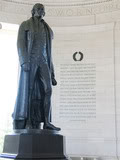
Jefferson Memorial
Washington, DC
With Declaration of Independence Preamble in background
The Jefferson Legacy
Thomas Jefferson was the third President of the United States, the principal author of the Declaration of Independence, and one of the most influential Founding Fathers for his promotion of the ideals of republicanism in the United States. Jefferson’s twilight years were spent, in part, defining and defending his legacy. During his final decade, Jefferson drafted an autobiography, became increasingly concerned about the preservation of historical documents, and staunchly defended his role as author of the Declaration of Independence.
On the verge of death, he had designed his own gravestone and epitaph: “Author of the Declaration of Independence [and] of the Statute of Virginia for religious freedom and Father of the University of Virginia.” Though critics questioned his role in writing the Declaration of Independence, Jefferson insisted upon his authorship of the Declaration and reasserted his moral opposition to slavery. Nevertheless, Jefferson undoubtedly knew at his death on July 4, 1826, that the vagaries of life had left a vulnerable legacy.
An important effort undertaken by the founding generation of Americans was the development of major cultural institutions; one of these was the Library of Congress, which was established by Congress in 1800 as a reference library for Congress only. The first appropriations for the purchase of books were approved by President John Adams, and the first law defining the role and functions of the new Library were approved by President Thomas Jefferson in 1802, who also gave nearly his entire personal library to the Library of Congress after it was burned by the British in 1814.
Thomas Jefferson’s views on women in politics:
Jefferson was not an advocate of women; author Richard Morris wrote, “Abigail Adams excepted, Jefferson detested intellectual women. Annoyed by the political chatter of women in Parisian salons, he wrote home expressing the hope that ‘our good ladies… are contented to soothe and calm the minds of their husbands returning ruffled from political debate.'” While President, Jefferson wrote that “the appointment of a woman to office is an innovation for which the public is not prepared, nor am I.”
SOURCES
The Library of Congress > Exhibitions > Thomas Jefferson
The Jefferson Monticello
Life of Thomas Jefferson
Thomas Jefferson Marriage
Timeline of Jefferson’s Life
Thomas Jefferson 1743-1826
Thomas Jefferson Biography
Wikipedia: Thomas Jefferson
First Ladies of the United States
Martha Wayles Skelton Jefferson
Thomas Jefferson Digital Archive
Thomas Jefferson Autobiography
Wikipedia: Martha Wayles Jefferson
First Lady Biography: Martha Jefferson
President Thomas Jefferson 1801 – 1809
Thomas Jefferson, 2nd Vice President (1797-1801)
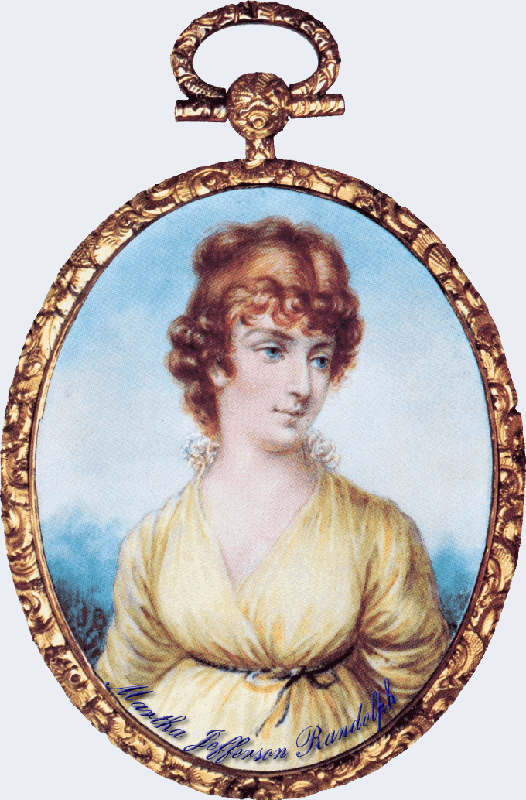
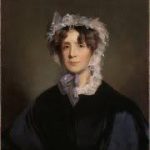
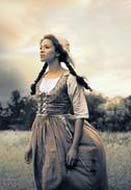
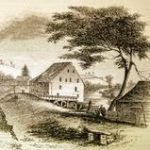
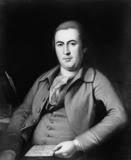
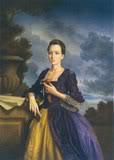
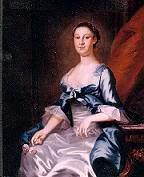
Are there any existing portraits of Martha Jefferson, as opposed to the one of her daughter shown here?
No, there are no portraits of Martha Wayles Jefferson known to exist. They are imaginings of what she might have looked like due to descriptions of her from her family, slaves, and visitors when she was mistress of Monticello. hope this helps…
Please remove the picture at the top. OR label it as his DAUGHTER, not his wife.